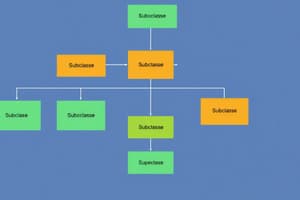Podcast
Questions and Answers
What is the result of adding more semantic constructs to the original entity-relationship (ER) model?
What is the result of adding more semantic constructs to the original entity-relationship (ER) model?
- An ER diagram
- A relational model
- An EER diagram (correct)
- A database schema
What is the term for the process of identifying more specific entity subtypes from a higher-level entity supertype?
What is the term for the process of identifying more specific entity subtypes from a higher-level entity supertype?
- Generalization
- Specialization (correct)
- Entity-Relationship
- Inheritance
What type of entity contains common characteristics and participates in relationships that are inherited by its subtypes?
What type of entity contains common characteristics and participates in relationships that are inherited by its subtypes?
- Entity Relationship
- Entity Supertype (correct)
- Entity Subtype
- Entity Attribute
What is the relationship between a supertype and its subtype(s) at the implementation level?
What is the relationship between a supertype and its subtype(s) at the implementation level?
What is the term for the process of creating a higher-level entity supertype from more specific entity subtypes?
What is the term for the process of creating a higher-level entity supertype from more specific entity subtypes?
What notation is recommended for EER diagramming?
What notation is recommended for EER diagramming?
What is represented in Figure 12?
What is represented in Figure 12?
What type of relationship is depicted in Figure 15?
What type of relationship is depicted in Figure 15?
What is the purpose of Figure 17?
What is the purpose of Figure 17?
What is being transformed in Figure 20?
What is being transformed in Figure 20?
What type of relationship is depicted in Figure 30?
What type of relationship is depicted in Figure 30?
What is being transformed in Figure 32?
What is being transformed in Figure 32?
How do you map a simple attribute in E-R diagrams to relations?
How do you map a simple attribute in E-R diagrams to relations?
What happens to a multivalued attribute when transforming EER diagrams into relations?
What happens to a multivalued attribute when transforming EER diagrams into relations?
How is a weak entity mapped to a relation?
How is a weak entity mapped to a relation?
What is the primary key composed of in a weak entity relation?
What is the primary key composed of in a weak entity relation?
What is the default primary key for an associative entity?
What is the default primary key for an associative entity?
How do you map a one-to-many binary relationship in EER diagrams to relations?
How do you map a one-to-many binary relationship in EER diagrams to relations?
Study Notes
Entity-Relationship Model Enhancements
- Adding more semantic constructs to the original ER model enhances data representation, capturing complex relationships and constraints.
- This process improves the clarity and usability of the data model by incorporating richer data semantics.
Subtyping in Entity-Relationship Models
- Identifying more specific entity subtypes from a higher-level entity supertype is known as subtyping.
- A supertype contains general characteristics that are shared among its related subtypes, facilitating inheritance of relationships.
Implementation Levels and Relationships
- A supertype and its subtype(s) exhibit a hierarchical relationship, where subtypes inherit properties and behaviors from the supertype at the implementation level.
- This structure allows for more efficient data management and reduces redundancy.
Creating Higher-Level Supertypes
- The process of creating a higher-level entity supertype from more specific entity subtypes is termed generalization.
- Generalization simplifies the data model, focusing on common features of subtypes.
EER Diagramming Notation
- Recommended notation for Enhanced Entity-Relationship (EER) diagramming includes specific symbols to depict supertypes, subtypes, and relationships effectively.
- This standardized notation helps in clearly visualizing entity relationships and hierarchies.
Figure Representations
- Figure 12 depicts a comprehensive view of the enhanced ER model, illustrating added constructs.
- Figure 15 illustrates a specialization relationship, where a supertype is divided into subtypes based on specific criteria.
- Figure 17 serves to clarify relationships or processes within the model's context, such as transformations stemming from acquired constraints.
- Figure 20 shows the transformation of EER constructs into relational schemas.
- Figure 30 illustrates a composition relationship, often representing how one entity is composed of sub-entities.
- Figure 32 highlights the transformation of the simplified entity structure into a more complex one for relational modeling.
E-R Diagram Mapping
- Mapping a simple attribute in E-R diagrams to relations involves directly corresponding the attribute to a column in the relational schema.
- Multivalued attributes are transformed into separate tables with a foreign key to the original entity, maintaining uniqueness.
- A weak entity is mapped to a relation by creating a new table with its attributes and the primary key of its owning entity.
- The primary key of a weak entity relation is composed of its own partial key combined with the primary key of the owning entity.
- The default primary key for an associative entity is typically a combination of the primary keys of the entities it associates.
- A one-to-many binary relationship in EER diagrams is mapped by creating a foreign key in the 'many' side entity that references the 'one' side entity's primary key.
Studying That Suits You
Use AI to generate personalized quizzes and flashcards to suit your learning preferences.
Description
Test your knowledge of advanced data modeling concepts, including the Extended Entity-Relationship (EER) model and its components, such as entity supertypes and subtypes. Evaluate your understanding of EER diagrams and their applications.



